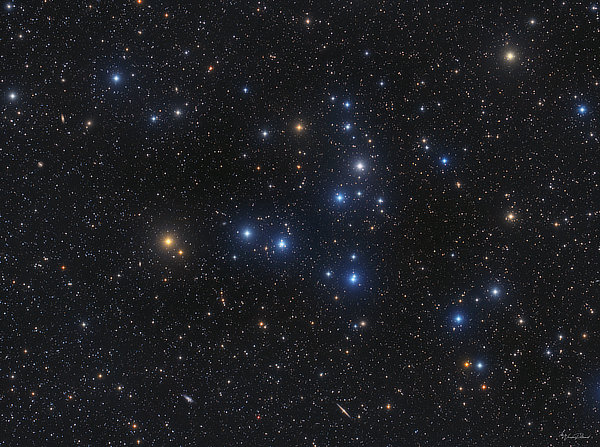Melotte in Coma Berenices
April 2024 - Nebula and Cluster of the Month
This month, we look at the question ‘what does an open cluster look like close-up?’ We have a small collection of nearby star clusters to choose from. The closest is the Ursa Major Moving Group. Arguably no longer a true open cluster, it appears that this stream of stars, all moving in the same direction and at the same speed, were at least once part of an open cluster. At the centre of the group, what would originally have been the core of the cluster, are five of the seven stars of the Plough. The stars at the ends of the asterism, α UMa (Dubhe) and η UMa (Alkaid or Benetnash) are not members, and can be measured as moving in entirely different directions.
In total, there are 35—40 naked-eye stars (depending on your sky conditions and visual acuity) which are members of the stream, the brightest of which is β Aur at magnitude 1.9. In total, nearly 60 stars are known to be part of the group. The brightest star in the sky, Sirius, was once thought to be a member, but this has now been disproved. The sun lies at the edge of the moving stream but is not itself a member, being many times too old. The stream stretches from Cepheus to Triangulum Australe, so cannot be said to have a great visual impact.
The closest still-intact open cluster is the Hyades, in Taurus. Lying around 150 light-years from Earth, the Hyades contains about 380 stars, the brightest of which is magnitude 4.0. It covers 5.5° of sky, 11 times the diameter of the full moon. It’s a familiar sight, representing the face of the bull. The first magnitude star α Tau (Aldebaran) is not a member, lying as it does, less than halfway between us and the Hyades.
Perhaps a better example of what an open cluster looks like close-up is the next closest, Melotte 111. This open cluster lies 100 light-years further away from us than the Hyades, at 260 light-years distant. However, even at this remove, it spans a greater amount of sky, being 7.5° across, giving it a true diameter of close to 35 light-years.

Melotte 111 is of course the asterism that makes up the most prominent part of the constellation of Coma Berenices, and is sometimes referred to as the ‘Coma Star Cluster’. In today’s constellation, it represents the hair of the Greek-Egyptian Queen Berenike II Euergetis, who reigned in her own capacity as queen of Egypt from 258 to 246 BC and as co-ruler with her husband, Ptolemy III Euergetes from 246 to 222 BC. The legend attached to the constellation relates how after the safe return of Ptolemy III from battle, Berenike made an offering of her famed hair (which was amber in colour, apparently) on the altar in the temple of Aphrodite at Cape Zephyrion. This offering subsequently disappeared, most likely stolen. In order to assuage the fury of the king and queen, the court astrologer, a man by the name of Conon convinced the royal couple that the hair had been accepted by the gods and placed in the heavens.
Before the hair incident (and occasionally for some time afterwards) the open cluster represented the tuft of hair at the end of Leo’s tail or a sheaf of wheat held in the left hand of Virgo. The name ‘Coma Berenices’ was fixed by Tycho Brahe in his catalogue of 1602, and has been in use ever since.
Current star counts give Melotte 111 some 273 member stars. The brightest, designated 12, 13, 16, 17, 21 and 22 Comae are all visible to the naked eye under good conditions, with the brightest, 12 Com, shining at magnitude 4.8. A curious feature of this open cluster is that it seems to contain no faint stars. There is a surprising cutoff at about magnitude 10.5 (for comparison the Sun at this distance would shine at magnitude 9.2), leading to the conclusion that, most unusually, it contains no red dwarf stars. There are also no giant stars, though the H-R diagram shows some stars just beginning their journey to the giant stage.
The age of the Coma cluster is calculated at 450 million years, barely a tenth of the age of the Solar System.
The best option, then, if you want to know what an open cluster looks like close-up, is to step out on an April evening and look up towards Coma Berenices. There, lying midway between α CVn (Cor Caroli) and β Leo (Denebola) lies a twinkling, misty patch. The darker your skies, the better you will see it, of course. See how many individual stars you can discern. If you can see four or five, you’re doing well.
Then look through a pair of binoculars. It’s a wonderful sight, a northward-pointing arrowhead fills the field of view of standard 10x50s. There it is: a lovely open cluster that is, at least cosmically speaking, right on our doorstep.
| Object | RA | Dec | Type | Magnitude |
|---|---|---|---|---|
| Melotte 111 | 12h 25m 21s | +25° 59’ 28” | Open cluster | 1.8 |